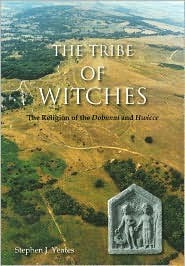Academic reviews
"Yeates brings into this discussion a variety of evidence, including material from archaeology, epigraphy, onomastics, imagery, folk tradition, religion, landscape studies and history of the Roman and early medieval periods. His principal foci are religion and landscape, and it is through intensive investigation of these two topics that he addresses the question of continuity from the earlier group to the later. As he explains, the beliefs and practices of the pre-Christian religions of Britain are difficult to ascertain but, in pulling together diverse kinds of evidence, the author attempts to draw connections between religious ideas in the late prehistoric Iron Age, the Roman Period and the early Middle Ages."
Peter S. Wells, 2009. [16] Peter S. Wells of the University of Missouri reviewed The Tribe of Witches for the Cambridge Archaeological Journal in 2009. Wells criticised Yeates' use of the word "tribe" to refer to both the Dobunni and the Hwicce, believing that another term might have been more appropriate. He also criticised the use of maps, believing that they were unhelpful, in particular for anyone not familiar with the regional landscape. Considering the text to be "very engaging", he noted that the bibliography was "extensive and valuable", with good use of illustrations. Nonetheless, Wells thought Yeates' primary argument to be unconvincing, highlighting the fact that depictions of females holding vessels were widespread across the Roman world, and not localised to the region of the Dobunni. [16]
Time and Mind: The Journal of Archaeology, Consciousness and Culture published a review authored by the folklorist Jeremy Harte. Taking a largely negative attitude towards The Tribe of Witches, he proclaimed that the work greatly resembled the sort of approach that he would have expected from a 19th-century antiquarian. Although applauding Yeates' extensive use of referencing, he stated that many of Yeates' basic arguments were wrong and that several of Yeates' statements were misleading. Noting that "whole chapters are little more than a repetition of possibilities", he condemned much of the book's argument by remarking that much of Yeates' sacred landscape consists of "nonexistent sites" that were "created by analogy with other sites which are not there either." Ultimately, he accepted that although a "colorful book", The Tribe of Witches resembled "historical romance" more than historical scholarship. [17]
Another largely negative review, this time written by the Celticist Simon Rodway of the University of Aberystwyth, appeared within Britannia: A Journal of Romano-British and Kindred Studies . Admitting that from the back cover he expected The Tribe of Witches to be filled with "wild claims", he was surprised that these claims were "merely hinted at" most of the time; he found it difficult to describe the book as "an ambitious work" due to the fact that while a broad swathe of material is dealt with, most of it is examined only perfunctorily, leaving Rodway with the impression that Yeates "has lost interest in his subject entirely." Stating that Yeates' hypothesis was hidden within a "pseudo-Nennian heap", he chastises the author for failing to provide sufficient evidence to support his claims for an Iron Age/Medieval cultural continuity, and for failing to propose how such a continuity had been maintained; he highlights that Yeates' argument here is similar to Nicholas Higham's "problematic" theory of a largely peaceful language shift from Celtic to Germanic. Although remarking that he was unfit to judge Yeates' use of the archaeological material, he did note that the author's use of historical sources was "adequate at best" while his use of onomastics was "woeful"; remarking that Yeates clearly belonged to "the 'sounds a bit like' school of etymology", he states that Yeates has also failed to understand the arguments of many of the onomasticians whom he is citing and that "[a]ny novice historical linguist" could have told the author that his "tribe of witches" was a "phantom". Furthermore, highlighting that "very few pages are free of basic errors", he describes Yeates' thinking as "muddled" and ultimately considered The Tribe of Witches to be a "shallow, muddled and thoroughly underwhelming book" of no use to the scholarly study of either the Dobunni or Hwicce. [18]
Other peer-reviewed journals to publish reviews included Oxoniensia and Transactions of the Birmingham & Warwickshire Archaeological Society.
In a short review published in British Archaeology, the magazine of the Council for British Archaeology, the landscape archaeologist Della Hooke of the University of Birmingham criticised Yeates' book, labeling it a "bold attempt" but opining that it lacked sufficient evidence for many of its conclusions. Arguing that his arguments were "intriguing but unproven", Hooke felt that it was "unwise" to publish Yeates' conclusions in a "popular concise form" where they would reach a larger non-academic audience. She furthermore attacked his theory that the Hwicce took their name from an Iron Age witch stirring a sacred cauldron, claiming that it "verges upon fantasy." [19]
Wider reception
Writing on The Druid Grove website, a reviewer going by the pseudonym of Kestrel referred to Yeates' work as "a most interesting book" but expressed reservations about his theories regarding the mother goddess with her tub being symbolic of the valley. [20] Another Contemporary Pagan, D. James, reviewed the book on the Twisted Tree Bookshelf website. James believed that the book should be read by contemporary Pagans, and that it "significantly increases our understanding of the social and religious structures of our ancient forebears and is worthy addition to any bookshelf." [21] Linguist Steven Posch writes that since witchcraft did not become a religion until the 20th century, any attempts to derive it from a tribal religion of more than 1000 years previous are ultimately tendentious, and suggests that Yeates worked backwards from modern Wicca, "doing his damnedest to find a Triple Goddess paired with a God of Hunting—and better it be if he's horned." Posch holds that the book is of importance to modern pagans as mythic, rather than historic, history, and that Yeates' vision of a paganism grounded in the local landscape offers a template for contemporary pagan praxis. [22]
